For all
practical purposes, building AFV models and figures as a "serious"
hobby began in the early 1970s, led by Tamiya, Monogram and Airfix.
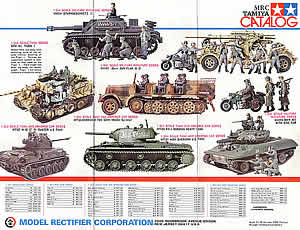 Tamiya
offered several basic U.S. AFVs including the M4A3 Sherman, the
M3 Lee, the M5A1 Stuart, the Willys Jeep and its amphibian counterpart,
and several variants of the M3 halftrack series. The company continued
to periodically reissue these kits, as they produced new German
models. While the Sherman is proving it has as many lives as a cat
(it has been the basis for four subsequent kits), many of these
other kits are lacking in accuracy or details. A number of them
were motorized, which compromised dimensional accuracy in order
to accommodate motors and batteries. Tamiya
offered several basic U.S. AFVs including the M4A3 Sherman, the
M3 Lee, the M5A1 Stuart, the Willys Jeep and its amphibian counterpart,
and several variants of the M3 halftrack series. The company continued
to periodically reissue these kits, as they produced new German
models. While the Sherman is proving it has as many lives as a cat
(it has been the basis for four subsequent kits), many of these
other kits are lacking in accuracy or details. A number of them
were motorized, which compromised dimensional accuracy in order
to accommodate motors and batteries.
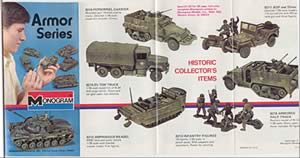 The
American company Monogram was Tamiya's most significant competitor
in this area, producing 1/32-scale kits that were quite respectable
for their day. Part of this respectability came from a former GI
named Sheperd Paine, who became the first widely recognizable modeler
with his smart looking dioramas. Monogram saw his skills as a marketing
opportunity and engaged Paine to create a series of instruction
sheets, printed in color, showing how to build these kits and use
them in scenic dioramas. Many now-middle-aged modelers fondly recall
these inspiring sheets, and Paine followed them with two seminal
softcover books on the subject: How to Build Dioramas and
Modeling Tanks and Military Vehicles, still published by
Kalmbach books. The
American company Monogram was Tamiya's most significant competitor
in this area, producing 1/32-scale kits that were quite respectable
for their day. Part of this respectability came from a former GI
named Sheperd Paine, who became the first widely recognizable modeler
with his smart looking dioramas. Monogram saw his skills as a marketing
opportunity and engaged Paine to create a series of instruction
sheets, printed in color, showing how to build these kits and use
them in scenic dioramas. Many now-middle-aged modelers fondly recall
these inspiring sheets, and Paine followed them with two seminal
softcover books on the subject: How to Build Dioramas and
Modeling Tanks and Military Vehicles, still published by
Kalmbach books.
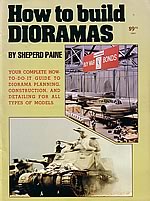 Alas,
Tamiya's growing dominance made 1/35 scale the de facto size for
AFV kits, and Monogram was beset with a growing disinterest in "war
models" as the Vietnam debacle widened and the poor American
economy in the mid-1970s. Ultimately they merged with archrival
Revell. The erstwhile 1/32 kits were occasionally reissued up until
the mid-1990s. Alas,
Tamiya's growing dominance made 1/35 scale the de facto size for
AFV kits, and Monogram was beset with a growing disinterest in "war
models" as the Vietnam debacle widened and the poor American
economy in the mid-1970s. Ultimately they merged with archrival
Revell. The erstwhile 1/32 kits were occasionally reissued up until
the mid-1990s.
Likewise,
Airfix made an attempt in this market in both 1/32 and 1/72 scales.
They are remembered most fondly for their "multipose"
sets of six and 12 figures, where body parts could easily be mixed
and matched to create different poses. While lacking the crisp definition
that we enjoy with many of today's injection molded and resin figures,
the Airfix GI and Marine sets can still be useful if they can be
found.
Italeri
appeared in the early 1980s. They purchased the molds for a series
of Dodge vehicles from Peerless Max, and produced the first models
of significant American artillery pieces, the 105mm and 155mm howitzers.
Their M4A1 Sherman still holds up quite well today, and they produced
an M4A3 Calliope, M36 Jackson, M32 recovery vehicle, M7 Priest and
a couple decent Jeep versions.
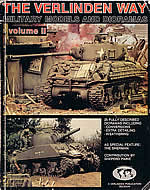 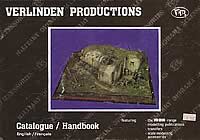 Shep
Paine's detailing kits and building dioramas paralleled the interests
of a Belgian named François Verlinden, who moved from modeler
to hobby store owner to manufacturer of resin update sets, photoetch
detail parts and figures. Almost single-handedly, Verlinden launched
the "aftermarket" industry for AFV kits, promoting his
products through nice color catalogues and a modeling and diorama
books. Soon "The Verlinden Way" was road most traveled
by a growing number of AFV modelers. Shep
Paine's detailing kits and building dioramas paralleled the interests
of a Belgian named François Verlinden, who moved from modeler
to hobby store owner to manufacturer of resin update sets, photoetch
detail parts and figures. Almost single-handedly, Verlinden launched
the "aftermarket" industry for AFV kits, promoting his
products through nice color catalogues and a modeling and diorama
books. Soon "The Verlinden Way" was road most traveled
by a growing number of AFV modelers.
New
Stars Rise in the East and West
For
many years, modelers had to satisfy themselves with reissues of
the older offerings from Tamiya, Monogram and Airfix and "fix-it"
sets from the aftermarket companies. But in the 1990s three factors
converged that have really set the course for AFV modeling as we
know it today.
First,
the market was growing because men who first got their taste of
modeling as young boys in the 1960s and 70s (like myself) were now
older and had more disposable income, more time and the need for
a hobby.
The
second factor was the emergence of the Internet, with web sites
and discussion groups dedicated to modeling AFVs. The exchange of
kit information, historical research, and how-to tips ignited created
a camaraderie among modelers in far flung areas of the world and
quickened the learning curve, resulting in innumerable photo galleries
of stunning work.
Finally,
Tamiya began to face some strong competition from Dragon Models
Limited in Hong Kong, which was releasing new Mk. IV's and Stugs
on a seemingly weekly basis. With the collapse of communism in Eastern
Europe, a number of smaller plastic and resin companies emerged,
often tackling the more exotic subjects.
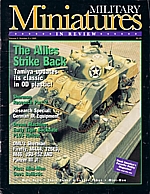 There
has been a resurgence in U.S. and other Allied armor. Perhaps realizing
that the German market was quickly being saturated by a growing
number of competitors, Tamiya released its first new U.S. WWII tank
in more than 15 years, the M4 Sherman, in 1994. In relatively rapid
succession (rapid for Tamiya, too slow for us!) they followed with
the M8 Greyhound and M20 armored cars, the GMC 6x6 2.5-ton truck,
the massive M26 Dragon Wagon, and a newly tooled jeep. There
has been a resurgence in U.S. and other Allied armor. Perhaps realizing
that the German market was quickly being saturated by a growing
number of competitors, Tamiya released its first new U.S. WWII tank
in more than 15 years, the M4 Sherman, in 1994. In relatively rapid
succession (rapid for Tamiya, too slow for us!) they followed with
the M8 Greyhound and M20 armored cars, the GMC 6x6 2.5-ton truck,
the massive M26 Dragon Wagon, and a newly tooled jeep.
DML
answered our prayers with an early M4A1 Sherman, a couple of Sherman
Firefly variants, and WWII and Korean War versions of the Pershing
tank. Several of the Shermans incorporated parts from Italeri's
earlier kits.
Italeri,
however, has been slower to come to the modeler's workbench with
new U.S. kits. They had the misfortune of releasing their M8 and
M20 armored cars after Tamiya's had already hit the market (while
the quality is not quite on par with the Tamiya kits, Italeri's
are considerably less expensive). They have broken new ground, however,
with the LVT-4 Amtrac and the upcoming DUKW. Even though the Amtrac
has been available in (expensive) resin for some time, Italeri's
kit has sparked Verlinden and Warriors to produce an unparalleled
number of new Marine figures and update kits.
In
the mid-1990s, Verlinden moved to the U.S. and merged his production
company with the distribution arm run by American modeler and master
diorama builder Bob Letterman. The combined operations were victim
to internal conflicts and a "divorce" was decreed before
the end of the decade. The misbegotten arrangement did result in
some lower pricing on Verlinden products, and VLS was forced to
acquire several companies, including Warriors and Custom Dioramics,
in order to replace the departed production operations. This hasn't
had much direct effect on the range of U.S. themed products, however.
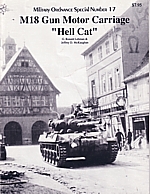 Three
newer companies have also played a significant role in fostering
new interest in Allied subjects. In 1998, Academy (overcoming its
earlier history as a purveyor of pirated Tamiya kits) came out with
nice kit of the M18 Hellcat - only to face direct competition from
a Hellcat produced by AFV Club. Currently the two companies are
going toe-to-toe with M10 tank destroyers (Tamiya, perhaps seeking
a bit of revenge, reissued their inferior M10 at the same time Academy's
hit the market). Academy has also given us the M12 GMC gun and new
early Stuart tanks. AFV Club has issued a number of excellent link-to-link
track sets for light tanks and Shermans. Three
newer companies have also played a significant role in fostering
new interest in Allied subjects. In 1998, Academy (overcoming its
earlier history as a purveyor of pirated Tamiya kits) came out with
nice kit of the M18 Hellcat - only to face direct competition from
a Hellcat produced by AFV Club. Currently the two companies are
going toe-to-toe with M10 tank destroyers (Tamiya, perhaps seeking
a bit of revenge, reissued their inferior M10 at the same time Academy's
hit the market). Academy has also given us the M12 GMC gun and new
early Stuart tanks. AFV Club has issued a number of excellent link-to-link
track sets for light tanks and Shermans.
But
perhaps the most impressive offerings came from Skybow, an entry
from Taiwan. They took it upon themselves to update the Dodge series
with newly tooled versions of General Patton's WC57 Command Car,
the WC51 Weapons Carrier and the WC63 truck. These kits, along with
their Vietnam era vehicles, have earned rave reviews for their precise
detail, accuracy, and "build-ability." Alas, Skybow fell
on hard times financially, but the products were picked up by AFV
Club.
For
those with a lot of cash on hand, resin companies such as Accurate
Armour, Roy Models and PSP are offering challenging opportunities
to build large workhorses like the Diamond T, M1A1 Ward LaFrance
and M4 high speed tractor. These vehicles likely wouldn't produce
the profits necessary for a plastics company like Tamiya or DML
(Nitto produced a dog of an M4 or M5 tractor in plastic that needs
quite a bit of work, but it's out of production and hard to find).
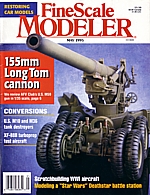 Towed
artillery and anti-tank guns tend to be overlooked by modelers under
any flag, and hence there are only a few options available. The
most impressive in both size and quality is AFV Club's 155mm "Long
Tom." Italeri offers a couple twenty-year-old moldings of the
105mm and 155mm howitzers that need some TLC and detailing to bring
to life. Zvezda now reboxes the M1 anti-tank gun from Italeri; this
is the American version of the British-designed gun that is available
in a lesser quality kit from Tamiya. A metal kit of the 75mm field
"pack" howitzer was made by Tamiya in the early 70's but
it's a rare find these days. Towed
artillery and anti-tank guns tend to be overlooked by modelers under
any flag, and hence there are only a few options available. The
most impressive in both size and quality is AFV Club's 155mm "Long
Tom." Italeri offers a couple twenty-year-old moldings of the
105mm and 155mm howitzers that need some TLC and detailing to bring
to life. Zvezda now reboxes the M1 anti-tank gun from Italeri; this
is the American version of the British-designed gun that is available
in a lesser quality kit from Tamiya. A metal kit of the 75mm field
"pack" howitzer was made by Tamiya in the early 70's but
it's a rare find these days.
March,
March, March
DML,
which has risen to the top of the pack with figures imaginatively
designed and illustrated by Ron Volstad, has produced just eight
WWII American soldier sets over the past decade and even fewer British
and Russian figures (French soldiers typically were outfitted with
American uniforms and gear). They have churned out over three dozen
German sets, including cavalry! We await (only half jokingly) such
new sets as "Germans Peeling Potatoes, Ukraine 1943" and
"German Signal Troops Polishing Boots." But DML did step
up to the plate in late 2003 and 2004 with nice anti-tank and light
weapons teams, and an Omaha Beach set to commemorate the 60th anniversary
of D-Day. They are now reboxing many of their figure sets to include
new weapons and equipment sprues.
Likewise,
Tamiya has been preoccupied with German figures, though they did
release an excellent six man U.S. assault team (we were all hoping
their impressive box of 16 Russian soldiers was going to be a new
packaging trend, but it came to naught). And the Japanese goliath
did serve up some new winter GIs with their two revamped Sherman
sets. Italeri had a "Russian phase" in the mid-90s, offering
Cossacks on horseback, assault teams and naval troops, but no new
Americans since their bug-eyed paratroopers, Marines, and quasi-American
figure retreads from Heller, all from more than 20 years ago.
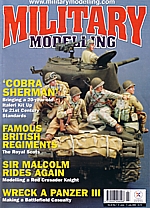 There
have been more opportunities available in resin, albeit at a higher
price. In the past few years there has been a stronger showing of
American might in the Verlinden and Custom Dioramics lines. A smattering
of figures is found in other product lines. There
have been more opportunities available in resin, albeit at a higher
price. In the past few years there has been a stronger showing of
American might in the Verlinden and Custom Dioramics lines. A smattering
of figures is found in other product lines.
Our
greatest hope, an upstart company called YANKS, offered only U.S.
and Russian soldiers. They passed from the scene in the late 1990s
(the molds were sold to a Scottish company which promptly shut down
as well). An attempt to resurrect YANKS failed, though some of the
product line has been picked up by Mustang Productions.
But
two other companies—Formations and Tiger Model Designs—are
winning many fans with accurate and intricately cast upgrade sets
and accessories. And for those into correcting and super-detailing
their kits, Eduard and Aber continue to offer a wide and seemingly
endless array of photo-etch doodads.
On
the Horizon
The
manufacturing side of the industry seems to have a split personality
these days. On one hand, they'll take some pretty surprising risks,
such as Tamiya's Dragon Wagon and VLS's "superdiorama"
sets. And on the other hand, they seem to wait for someone else
to take the lead. The airing of Band of Brothers in the fall
of 2001 prompted a sudden rush of airborne and melton-coated infantry
figures. Italeri's release of the Amtrac has led to a virtual battalion
of Marines from Warriors and Verlinden Productions. While VLS's
production companies such Custom Dioramics produce some great, unique
products, VLS also seems intent on duplicating many of the products
from its former partner, Verlinden. So we get new sets of crates,
bottles, fuel drums and wicker baskets when what we really need
are mess kits, cook stoves, tents, and accurately sized ammo crates
and markings.
Tamiya
seemed preoccupied with 1/16 remote control tanks (funny how we
sought to get away from motorized kits, which we smugly thought
were for "kids."). But in late 2004, rumors began to circulate
about a new line of 1/48 armor. DML shifted much of its interest
away from 1/35 kits and figures in order to concentrate on its more
profitable 12" "action figures," and in fact has
publicly complained that AFV modelers are too critical of its kits
and they may get out of plastic tanks and soldiers altogether! But
those appear to be idle threats, as DML began branching out into
1/72 scale kits, perhaps following the lead of Italeri and Revell.
The
wars in Afghanistan and Iraq have also taken modeling resources
and attention away from WWII. These fronts in the "war on terrorism"
are in many ways more akin to the conflict in Viet Nam than to fight
against fascism, particularly with regard to public sentiments.
At this point, it's unlikely they will have the negative affect
on modeling AFVs as Viet Nam had with all sorts of military toys
and hobbies. There is a renewed respect for veterans from all U.S.
wars, especially as we witness the inevitable passing of "the
Greatest Generation," with over 1,000 vets making their final
roll call each day.
But
they will not pass from memory as long as we modelers continue to
commemorate their service and sacrifice in our own small way.
-tss-
| 











